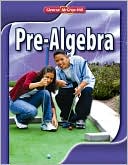
Whether the statement “The set of quadrants includes positive whole numbers, their opposites and zero.” is true or false. If false, replace the underline word.
Answer to Problem 6SGR
The given statement is false. The set of integers includes positive whole numbers, their opposites and zero.
Explanation of Solution
In a coordinate axis, there are four quadrants. The set of quadrants does not include any whole number or zero.
An integer is a number which can be positive, negative or zero. An integer does not include fractions.
Examples of integers are 0, 1, -2, 5 etc.
A set of integers include positive whole number, zero and negative whole number.
Thus, the given statement is false. The set of integers includes positive whole numbers, their opposites and zero.
Chapter 2 Solutions
Pre-Algebra, Student Edition
Additional Math Textbook Solutions
Basic Business Statistics, Student Value Edition
Calculus: Early Transcendentals (2nd Edition)
A First Course in Probability (10th Edition)
College Algebra with Modeling & Visualization (5th Edition)
Algebra and Trigonometry (6th Edition)
- Calcúlate the cross product of v and warrow_forwardConsider the following elevation function for a region of irregular terrain: z(x, y) = 1 x² + y² 25 Here, z is the elevation of the terrain over a point (x, y) with x and y being the horizontal coordinates. The region of interest lies between x = 0 and x = 5, and y 0 and y = 5. Your tasks are the following: = 1. Analyze how the elevation changes with respect to x and y. To find the elevation changes, calculate the partial derivatives of the elevation function z with respect to x and 2. Calculate the total volume of soil above the 0-level (z region of interest. = y. 0). To do so, integrate z(x, y) over the wholearrow_forwardA truck loaded with rocks weighs 14,260 lb. If the truck weighs 8420 lb, how much do the rocks weigh?arrow_forward
- Make up two polynomial functions, f(x) and g(x). • f(x) should be of degree 3 or higher. g(x) should be of degree 4 or higher. • Find f(3) in each of the three ways: substitution, remainder theorem (synthetic division), and long division. You should get the same answer three times for f(3). Find g(-2) once using your choice of the three methods.arrow_forwardere are many real-world situations that exhibit exponential and logarithmic nctions. • Describe two real world scenarios, one exponential and one logarithmic. Do not identify yet whether your scenarios are logarithmic or exponential.arrow_forwardstacie is a resident at a medical facility you work at. You are asked to chart the amount of solid food that she consumes.For the noon meal today, she ate 1/2 of a 3 ounce serving of meatloaf, 3/4 of her 3 ounce serving of mashed potatoes, and 1/3 of her 2 ounce serving of green beans. Show in decimal form how many ounces of solid food that Stacie consumedarrow_forward
- I've been struggling with this because of how close the numbers are together!! I would really appreciate if someone could help me❤️arrow_forwardMatrix MЄ R4×4, as specified below, is an orthogonal matrix - thus, it fulfills MTM = I. M (ELES),- m2,1. We know also that all the six unknowns mr,c are non-negative with the exception of Your first task is to find the values of all the six unknowns. Think first, which of the mr,c you should find first. Next, consider a vector v = (-6, 0, 0, 8) T. What's the length of v, i.e., |v|? Using M as transformation matrix, map v onto w by w = Mv provide w with its numeric values. What's the length of w, especially when comparing it to the length of v? Finally, consider another vector p = ( 0, 0, 8, 6) T. What's the angle between v (from above) and p? Using M as transformation matrix, map p onto q by q = Mp - provide q with its numeric values. What's the angle between w and q, especially when comparing it to the angle between v and p?arrow_forward7. (a) (i) Express y=-x²-7x-15 in the form y = −(x+p)²+q. (ii) Hence, sketch the graph of y=-x²-7x-15. (b) (i) Express y = x² - 3x + 4 in the form y = (x − p)²+q. (ii) Hence, sketch the graph of y = x² - 3x + 4. 28 CHAPTER 1arrow_forward
 Algebra and Trigonometry (6th Edition)AlgebraISBN:9780134463216Author:Robert F. BlitzerPublisher:PEARSON
Algebra and Trigonometry (6th Edition)AlgebraISBN:9780134463216Author:Robert F. BlitzerPublisher:PEARSON Contemporary Abstract AlgebraAlgebraISBN:9781305657960Author:Joseph GallianPublisher:Cengage Learning
Contemporary Abstract AlgebraAlgebraISBN:9781305657960Author:Joseph GallianPublisher:Cengage Learning Linear Algebra: A Modern IntroductionAlgebraISBN:9781285463247Author:David PoolePublisher:Cengage Learning
Linear Algebra: A Modern IntroductionAlgebraISBN:9781285463247Author:David PoolePublisher:Cengage Learning Algebra And Trigonometry (11th Edition)AlgebraISBN:9780135163078Author:Michael SullivanPublisher:PEARSON
Algebra And Trigonometry (11th Edition)AlgebraISBN:9780135163078Author:Michael SullivanPublisher:PEARSON Introduction to Linear Algebra, Fifth EditionAlgebraISBN:9780980232776Author:Gilbert StrangPublisher:Wellesley-Cambridge Press
Introduction to Linear Algebra, Fifth EditionAlgebraISBN:9780980232776Author:Gilbert StrangPublisher:Wellesley-Cambridge Press College Algebra (Collegiate Math)AlgebraISBN:9780077836344Author:Julie Miller, Donna GerkenPublisher:McGraw-Hill Education
College Algebra (Collegiate Math)AlgebraISBN:9780077836344Author:Julie Miller, Donna GerkenPublisher:McGraw-Hill Education





